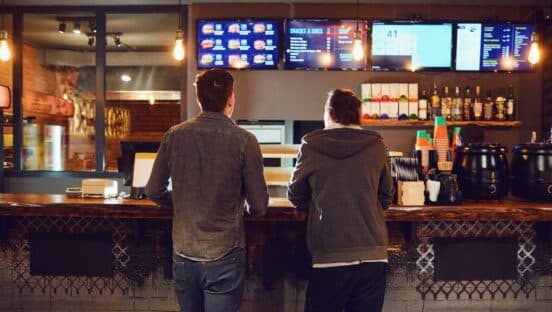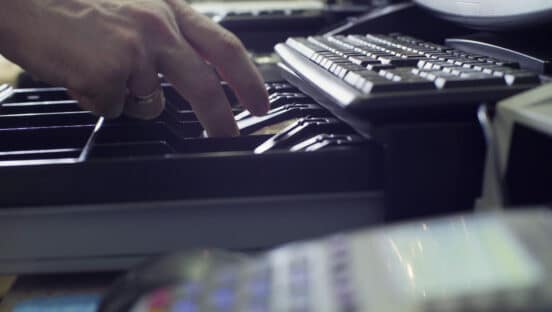Since the beginning of the COVID-19 pandemic, consumer behaviors and preferences have rapidly evolved. Consumers are demanding more and more convenience in every part of their lives, from the ways they choose to socialize to the ways they prefer to order food. In today’s world, a great customer experience is frictionless and fast—and technology can help unlock it.
According to The NPD Group, digital ordering rose 117 percent from February 2020 through February 2022. Consumers are more knowledgeable about tech than ever before, and often prefer contactless digital channels to interacting with restaurant staff when placing an order. In addition, nearly three quarters (73 percent) of respondents in an Annual Connected Retailer Survey conducted by SOTI were in favor of self-service technologies to improve shopping experience and reduce staff interactions. In just a few short years, contactless ordering channels have moved from a nice-to-have benefit for tech-savvy guests to table stakes for operating any foodservice establishment.
Of course, pandemic-related lockdowns were a driving force in changing consumers’ behavior patterns. Circumstances forced many people to quickly become more comfortable with digital ordering. Today, however, not only have consumers come to appreciate the convenience of contactless, digital ordering and payment, they may also view it as more sanitary. Many consumers are still paying closer attention to human interactions from a perspective of hygiene. “The pandemic transformed how people interact with each other and their surroundings,” says Jeffrey Brown, product manager at Advantech. “Now they’re looking for a more frictionless, safer ordering experience.”
[float_image image=”https://www.qsrmagazine.com/wp-content/uploads/2022/03/doghauscollaborationseries.jpg” width=”45″ link=”” caption=”” alt=”Dog Haus Donates To No Kid Hungry” align=”right” /]
Evolving to Meet Consumer Preferences
Many quick-service restaurants have introduced self-ordering kiosks in response to consumers’ changing preferences. They allow consumers to place their orders themselves, and the orders are sent directly to the kitchen. “Self-ordering kiosks remove certain social pressures,” Brown says. “If certain individuals want to avoid in-person interactions, especially since the pandemic, they can use a self-ordering kiosk. If they have food allergies or sensitivities, they can also get instant information about specific ingredients without having to rely on a human to remember correctly.”
When employees are no longer needed at the point of sale, human error—and its associated costs—can be lowered. Self-ordering kiosks can handle order taking, and staff can be reallocated to higher-value tasks. “You’re going to see reduced costs from order errors, and any other human errors when it comes to operations,” Brown says.
Mitigating Staff Shortages
In fact, kiosks can provide much-needed support for staffing shortages, as they work 24/7. “Staffing shortages are a drumbeat we keep hearing about in this day and age, and technology like kiosks can help bridge that gap,” says Russell Barber, web marketing lead at Advantech. Long lines and excessive wait times have caused havoc for quick-service customers and employees alike, but self-ordering kiosks can help line-bust during rush periods. This frees up the reduced staff to monitor the dining room, engage with customers, or work on other complex tasks that require a human to do.
A Personalized Experience
Self-ordering kiosks also allow more frictionless participation in loyalty programs, and restaurant owners and operators can also add upsell opportunities into the ordering flow. “A lot of quick-service restaurants have loyalty perks and weekly offers, and those can be instantly accessed once the customer gets to that kiosk,” Brown says. “Business owners can also use kiosks to upsell or cross-sell and increase revenue. They can choose to present certain opportunities to guests on the kiosks, like the option to add fries and a drink, and they can encourage guests to return with automatic offers and deals.”
Sales Data and Tracking Customer Behavior
In addition to greater convenience for customers and greater efficiency for staff, self-ordering kiosks also offer advantages for the back office. Restaurant operators can learn more about their customers from the data that kiosks generate, remaining in compliance with local data privacy regulations—and use that information to drive foot traffic and repeat business.
Self-ordering kiosks are a type of all-in-one computer, designed for environments where bulky equipment would be cumbersome. Advantech, a technology company that provides hardware and software to a variety of specialized industries, estimates that the use of all-in-one computers will continue to grow over the next five years by 4.6 percent. For the quick-service restaurant industry, Advantech offers a suite of all-in-one computer solutions to help boost efficiency and sales—like self-ordering kiosks and more.
“Advantech helps quick-service restaurants by providing a total computing solution that includes hardware and software building blocks,” Brown says. “We provide them with higher-quality systems than they’ve seen previously. Our solutions are rugged and allow for better longevity, as well as increased efficiency and the ability to customize branding elements. We have a great network of partners that we use to help build and customize our solutions.”
The company’s technology also integrates seamlessly with a wide variety of peripherals like card readers, fingerprint readers, and even facial recognition if restaurants want to experiment with cutting-edge technology as a way to increase guest satisfaction. “The ability to integrate advanced technology is definitely a benefit of Advantech offerings,” Barber says.
What’s New in Kiosk Technology
For example, Advantech is working on a prototype of a self-ordering kiosk that is entirely contactless. Guests can gesture at the screen from a distance of two or three inches to make selections, and 3D cameras will pick up the movements—potentially a game-changer in terms of hygiene and ease of use.
Conversational AI is another area where Advantech solutions are innovating. It’s clear that consumers are open to the idea of automated voice ordering—and many even prefer it. Deloitte recently found that four out of five people (81 percent of consumers) would rather speak to an automated voice system when ordering food from the drive-thru lane.
Advantech’s UTK-9000 kiosk, paired with a partner vendor’s conversational AI software, enables natural, human-like conversation using AI. “There’s a dialog manager that keeps track of the full length of the customer interaction,” Barber says. “It knows what was said and how it was said by the customer, so the kiosk has the context and the understanding. Brought together, we are moving toward more human-like interaction in these self-service kiosk interfaces.”
In quick-service restaurants, self-ordering kiosks open up new possibilities for the guest experience as well as for operational efficiency. Advantech solutions can help operators enter into the next phase of tech innovation.
To learn more, visit Advantech’s website.













